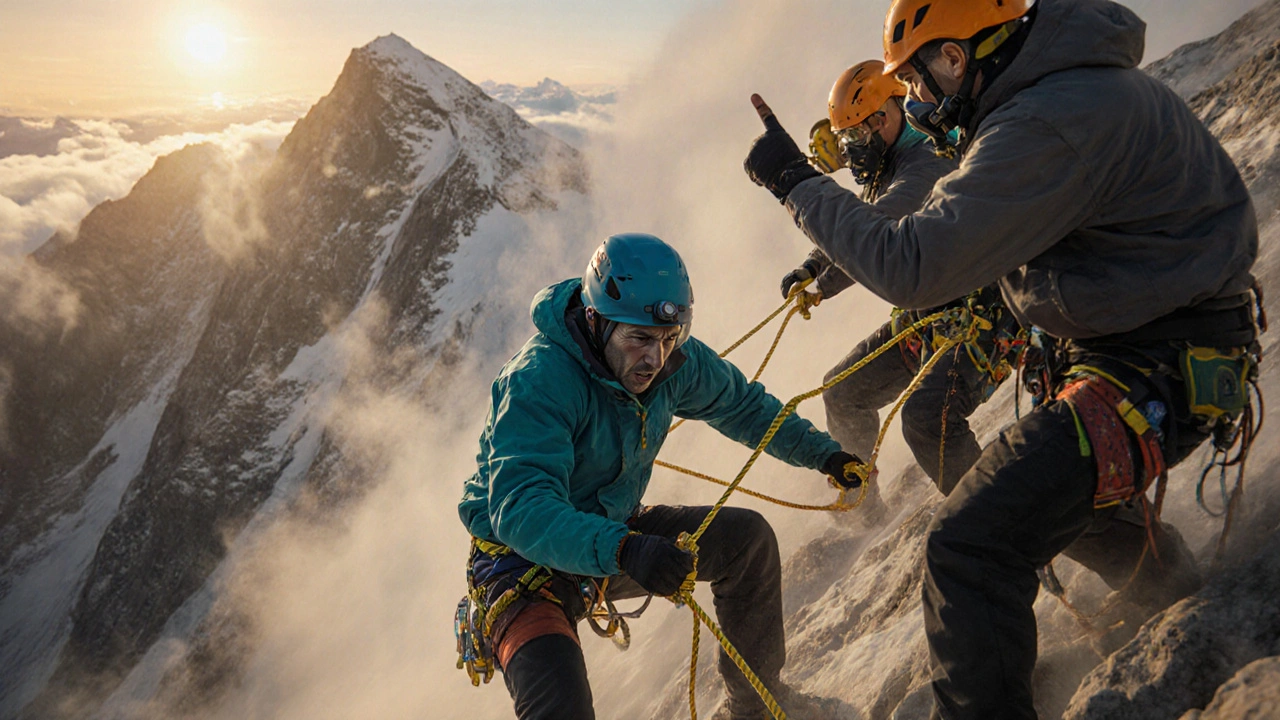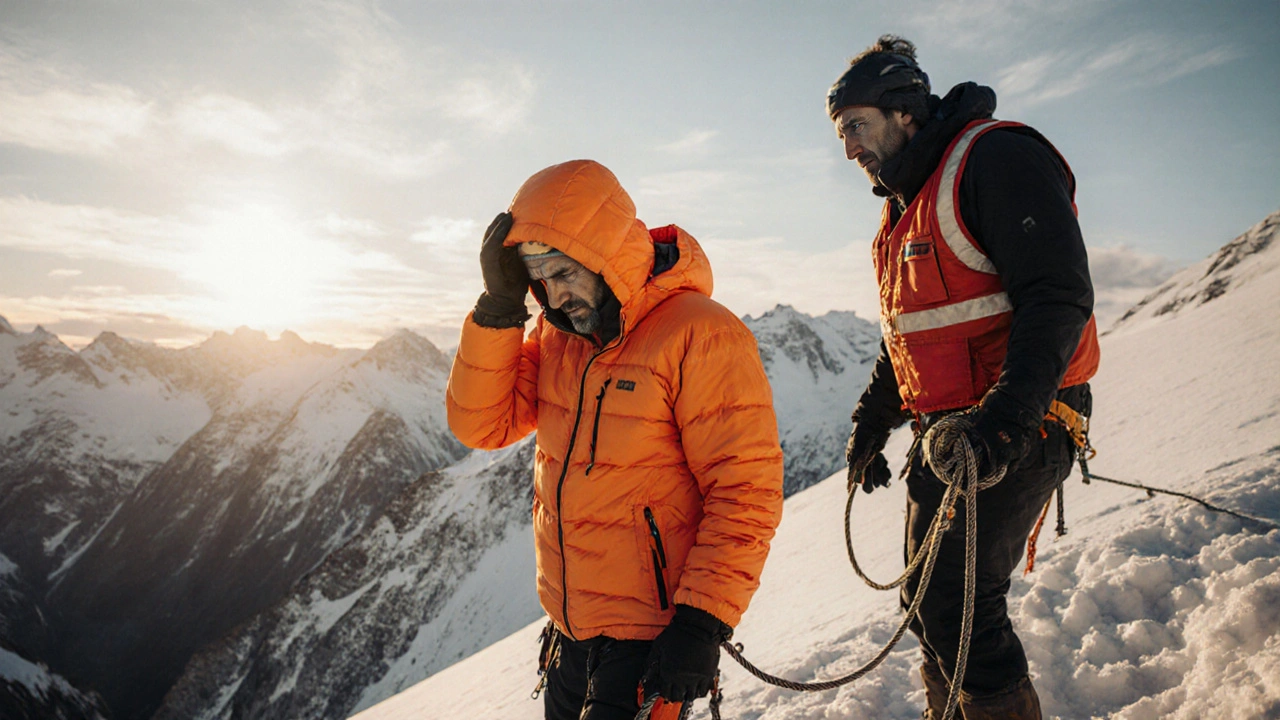High Altitude Cerebral Edema is a life‑threatening form of altitude illness that causes brain swelling due to low oxygen pressure at elevations above 3,000m. It hits fast, often within 24hours of rapid ascent, and can be fatal if ignored. The good news is that early recognition and swift intervention-mainly rapid descent, supplemental oxygen, and specific drugs-can reverse the damage.
How HACE Fits Into the Altitude‑Illness Spectrum
Most trekkers first encounter Acute Mountain Sickness is a mild to moderate syndrome marked by headache, nausea, and poor sleep. When the brain swells, the condition escalates into HACE. A third related disorder is High Altitude Pulmonary Edema which fills the lungs with fluid, causing extreme shortness of breath. While AMS and HAPE share hypoxia as a root cause, HACE is distinguished by neurological decline-confusion, ataxia, and even coma.
Spotting the Warning Signs
The transition from AMS to HACE is often subtle. Keep an eye on these hallmark symptoms:
- Severe headache that won’t ease with usual analgesics.
- Profound lethargy or difficulty staying awake.
- Loss of coordination (ataxia) - stumbling, inability to button a coat.
- Hallucinations or disorientation.
- Vomiting that continues despite rest.
Because hypoxia also triggers oxygen saturation drops below 80% in many HACE cases, a portable pulse oximeter can be a lifesaver.
Immediate First‑Aid: The Four‑Step Rescue Protocol
When you suspect HACE, act without hesitation. The following four actions have the highest survival odds:
- Rapid descent: Drop at least 1,000m (3,300ft) as quickly as safety allows. A descent of 600m within the first hour is often enough to halt progression.
- Supplemental oxygen: Deliver 2-4L/min of 100% O₂ via mask. Raising blood oxygen levels above 90% alleviates cerebral swelling.
- Dexamethasone: Administer 8mg IV/IM or 4mg orally every 6hours. This steroid reduces inflammation and improves cerebral blood flow.
- Acetazolamide (optional for mild cases): 250mg orally every 12hours speeds acclimatization by stimulating ventilation.
The order matters: descend first, then oxygen, then medication. If you’re trapped on a summit, a portable hyperbaric chamber can simulate a descent of 1,500m for a short period.
Medication Deep‑Dive: Dexamethasone vs. Acetazolamide
Both drugs target hypoxia but work differently. Dexamethasone is a potent glucocorticoid that shrinks brain tissue by dampening inflammatory pathways. It begins to work within 30minutes and is the drug of choice for established HACE.
In contrast, Acetazolamide is a carbonic anhydrase inhibitor that induces a mild metabolic acidosis, forcing the body to breathe faster and raise arterial oxygen. Its preventive strength shines on the ascent, reducing AMS incidence by up to 50% when taken 24hours before climbing.
Side‑effects to watch: dexamethasone can raise blood sugar and cause insomnia; acetazolamide may cause tingling in the fingertips and increased urination. Always check for contraindications such as uncontrolled diabetes or severe renal disease.
Preventing HACE: A Smart Acclimatization Blueprint
Prevention beats treatment every time. Follow these evidence‑based steps to keep your brain safe:
- Follow the Golden Rule of ascent: no more than 300m (1,000ft) gain per day above 2,500m, with a rest day every 3-4 days.
- Hydrate wisely-aim for 2.5-3L of fluid per day, but avoid over‑drinking which can dilute blood sodium and trigger hyponatremia.
- Consider a prophylactic dose of acetazolamide (125mg twice daily) for trips that exceed 3,500m.
- Carry a reliable pulse oximeter and check saturation every morning and evening.
- Plan your route to include low‑altitude camps for safe staging.
Even well‑trained climbers can fall victim to HACE if they ignore these rules-hypoxia respects no experience level.

When to Call for Rescue and How to Communicate
If a teammate displays any neurological decline, treat it as an emergency. Use a satellite messenger or radio to alert nearby rescue services. Provide them with:
- Exact altitude and GPS coordinates.
- Current oxygen saturation reading.
- Medications already administered (dose and timing).
- Estimated time of next descent.
Rescue teams often bring a portable hyperbaric chamber and supplemental oxygen, but they rely on your group to start the descent and medication immediately. Delay equals higher risk of permanent brain injury.
Quick Reference: Comparing Altitude Illnesses
| Feature | High Altitude Cerebral Edema | Acute Mountain Sickness | High Altitude Pulmonary Edema |
|---|---|---|---|
| Primary System Affected | Brain (neurological) | General (headache, nausea) | Lungs (fluid buildup) |
| Typical Onset | 6-24h after rapid ascent | 12-24h after ascent | 24-48h after ascent |
| Key Symptoms | Ataxia, confusion, severe headache, vomiting | Headache, loss of appetite, insomnia | Dyspnea at rest, cough with frothy sputum |
| First‑Aid Priority | Rapid descent + oxygen + dexamethasone | Hydration, rest, acetazolamide if needed | Descent + oxygen + nifedipine |
| Potential Fatality | High without treatment | Low | High without treatment |
Putting It All Together: A Sample Action Checklist
- Confirm altitude and check oxygen saturation. If below 80%, suspect HACE.
- Start rapid descent immediately-aim for 1,000m drop within the hour.
- Administer 2-4L/min of 100% supplemental oxygen via mask.
- Give 8mg dexamethasone IV/IM or 4mg PO.
- If you have a portable hyperbaric bag, inflate for up to 30minutes while descending.
- Monitor mental status every 15minutes; if no improvement, alert rescue.
- On reaching lower altitude, continue dexamethasone 4mg q6h for 24hours, then taper.
- Record the incident, medication times, and descent rate for future trips.
Practice this checklist during pre‑expedition briefings. Muscle memory saves lives when panic sets in.
Related Concepts Worth Exploring
Understanding HACE deepens when you also study the surrounding topics:
- Physiology of hypoxia and its effect on cerebral blood flow.
- The role of barometric pressure in fluid shift across the blood‑brain barrier.
- How intracranial pressure measurements guide treatment decisions.
- Guidelines from the World Health Organization (WHO) on high‑altitude medical protocols.
- Long‑term consequences of repeated altitude exposure on cognitive performance.
Each of these areas links back to the core entity-High Altitude Cerebral Edema-so you can build a comprehensive knowledge base before your next climb.
Frequently Asked Questions
What altitude does HACE usually start?
Most cases appear above 3,000meters (≈10,000feet), especially after a rapid gain of 600meters in a single day.
Can HACE be prevented with medication?
Acetazolamide helps prevent the early stages of altitude illness, but once brain swelling starts, dexamethasone and immediate descent are the only proven interventions.
Is a headache alone a sign of HACE?
A headache is common in acute mountain sickness. It only points to HACE when accompanied by neurological symptoms such as confusion or loss of coordination.
How long does dexamethasone take to work?
Clinical reports show improvement in mental status within 30-60minutes after a proper dose, especially when combined with supplemental oxygen.
Do portable hyperbaric chambers replace descent?
They buy you time by mimicking a 1,500‑meter descent, but they don’t cure HACE. Immediate physical descent remains the gold‑standard treatment.


Candace Jones
26 September / 2025Quick heads‑up for anyone heading above 3,000 m: keep an eye on that headache and any sudden drowsiness. If you start stumbling over simple tasks, that’s a red flag. Grab a pulse oximeter if you can – a drop below 80 % is scary. Pack enough oxygen canisters and dexamethasone for emergencies. And remember, the fastest way down is always the safest.